Avro Lincoln Video - Picture
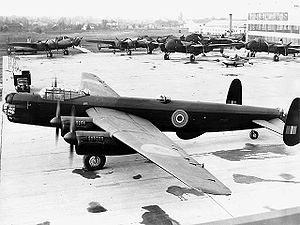
|
|
Avro Lincoln
Lincoln

Picture - The only Canadian built Avro Lincoln.
Role: Heavy bomber
Manufacturer: A V Roe and Metropolitan-Vickers
First flight: 9 June 1944
Introduced: 1945
Retired: 1967 Argentine Air Force
Primary users: Royal Air Force
Argentine Air Force
Royal Australian Air Force
Royal Canadian Air Force
Number built: 604
Developed from: Avro Lancaster
Developed into: Avro Shackleton
Avro Tudor
The Avro Type 694, better known as the Avro Lincoln, was a British four-engined heavy bomber, which first flew on 9 June 1944. Developed from the Avro Lancaster, the first Lincoln variants were known initially as the Lancaster IV and V, but were renamed Lincoln I and II. It was the last piston-engined bomber used by the Royal Air Force.
The Lincoln became operational in August 1945, too late to see action in the Second World War. It was assigned to units of Tiger Force, a British Commonwealth heavy bomber force, intended to take part in Allied operations against the Japanese mainland. However, the Lincoln did see action with the RAF during the 1950s, in the Mau Mau Uprising in Kenya and with the RAF and RAAF during the Malayan Emergency.
In all 604 Lincolns were built. The type also saw significant service with the Royal Australian Air Force (RAAF) and Fuerza Aérea Argentina (Argentine Air Force), as well as some civil aviation usage.
Design and development
The Avro Lincoln was Roy Chadwick's development of the Lancaster, built to the Air Ministry Specification B.14/43, having a longer span, higher aspect ratio (10.30 compared with 8.02) wings with two-stage supercharged Rolls-Royce Merlin 85 engines, and a bigger fuselage with increased fuel and bomb loads. As a result, the Lincoln had a higher operational ceiling and longer range than the Lancaster.
The prototype Lancaster IV (Lincoln I) was assembled by Avro's experimental flight department at Manchester's Ringway Airport and made its maiden flight from there on 9 June 1944.
The Lancaster V/Lincoln II differed mainly in that it was fitted with Merlin 68A engines.
Before the Lincoln was developed, the Australian government intended that its Department of Aircraft Production (DAP), later known as the Government Aircraft Factory (GAF) would build the Lancaster Mk III. Instead, a variant of the Lincoln I, renamed Mk 30 was built between 1946 and 1949, the largest aircraft ever built in Australia. Orders for 85 Mk 30 Lincolns were placed by the RAAF (which designated the type A-73), although only 73 were ever built.
The first five Australian examples (A73-1 to A73-5), were assembled from British-made components. A73-1 made its debut flight on 17 March 1946 and the first entirely Australian-built Lincoln, A73-6, was delivered in November 1946.
The Mk 30 initially featured four Merlin 85 engines, but was later equipped with a combination of two outboard Merlin 66s and two inboard Merlin 85s. The later Lincoln Mk 30A featured four Merlin 102s.
The RAAF heavily modified some Mk 30 aircraft for anti-submarine warfare during the 1950s, re-designating them Mk 31. These examples had a 6 ft 6 in (1.98 m) longer nose to house acoustic submarine detection gear and its operator, larger fuel tanks to give 13 hours endurance, and modifying the bomb bay to accept torpedoes. The Mk 31 was particularly difficult to land at night, as the bomber used a tailwheel and the long nose obstructed the pilot's view of the runway. 18 aircraft were remanufactured to this standard in 1952, gaining new serial numbers.
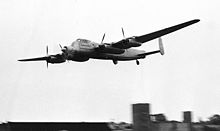
Picture - Avro Lincoln testbed G-37-1 at the Farnborough SBAC Show in 1956, flying solely on its nose-mounted Rolls-Royce Tyne
The Avro Shackleton maritime patrol aircraft was derived from the Lincoln, as was the Tudor airliner, which used the wings of the Lincoln with a new pressurised fuselage.
Operational history
No. 75 (New Zealand) Squadron RAF began re-equipping with Lincolns at RAF Spilsby during August 1945. However, 75 (NZ) Sqn received just three aircraft before VJ Day.
One Lincoln B Mk XV pattern aircraft was also completed in Canada by Victory Aircraft with an order for six RCAF variants cancelled when hostilities ended. Along with two additional (Mk I and Mk II) aircraft on loan from the RAF, the type was briefly evaluated postwar by the RCAF.
In the postwar Royal Air Force, the Lincoln equipped many bomber squadrons. Nearly 600 Lincolns were built to equip 29 RAF squadrons, mainly based in the United Kingdom. They were partially replaced by 88 Boeing Washingtons, on loan from the USAF, which had longer range and could reach targets inside the Iron Curtain.
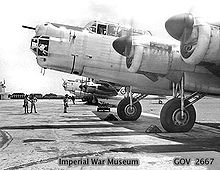
Picture - Lineup of the first operation of No. 1 Squadron, Royal Australian Air Force at RAF Tengah, Singapore, August 1950.
From late 1946, Australian-built Lincolns were phased into No. 82 Wing RAAF at RAAF Amberley, replacing the Consolidated Liberators operated by 12, 21 and 23 Squadrons. In February 1948, these units were renumbered 1, 2 and 6 Squadrons respectively; a fourth RAAF Lincoln squadron, No. 10 was formed on 17 March 1949 at RAAF Townsville as a reconnaissance unit.
The Lincoln served with the Fuerza Aerea Argentina from 1947: 30 aircraft were acquired (together with 15 Lancasters), giving Argentina the most powerful bombing force in South America.
RAF Lincolns were also used in combat during the 1950s, in Kenya against the Mau-Mau, and RAF and RAAF examples served in Malaya during the Malayan Emergency, against insurgents aligned to the Malayan Communist Party.
The Argentine aircraft were used in bombing missions against rebels during the attempted military coup of September 1951 and by both the government and rebel forces during the 1955 Revolucix³n Libertadora coup that deposed Juan Perx³n. Lincolns were also used to drop supplies in support of Argentinean operations in the Antarctic.
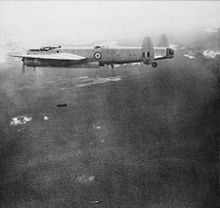
Picture - RAAF Lincoln bomber dropping 500 lb bombs on Communist targets during the Malayan Emergency, c. 1950
On 12 March 1953, a RAF Lincoln (RF531 "C") of Central Gunnery School was shot down 20 mi (32 km) NE of Lx¼neburg, Germany by a Soviet MiG-15 as it flew to Berlin on a training flight, resulting in the deaths of the seven crew members.
In November 1955, four Lincolns of No. 7 Squadron RAF were detached for duties in British territories in the Middle East. In Bahrain, they carried out border patrols of the then Trucial States. When 7 Sqn was disbanded in December 1955, the four detached crews and aircraft became No. 1426 Flight RAF, officially a photographic reconnaissance unit. It was later sent to Aden, carrying out patrols in the lead up to the Aden Emergency.
As the RAF Lincolns became unserviceable due to wear and tear they were replaced by Shackletons. The Lincolns of Bomber Command were phased out from the mid-1950s, and were completely replaced by jet bombers by 1963. The last Lincolns in RAF service were five operated by No. 151 Squadron, Signals Command, at RAF Watton, Norfolk, which were finally retired on 12 March 1963.
The RAAF Lincolns were retired in 1961, while Argentina continued to use its examples until 1967.
Use in aero-engine research
Lincolns were frequently employed as testbeds in new jet engine development. RF403, RE339/G and SX972 flew with a pair of Armstrong Siddeley Python turboprops outboard in place of the Merlins, and was used for the ballistic casing drop-test programme for the Blue Danube atomic weapon. SX972 was further modified to fly with a pair of Bristol Proteus turboprops. RA716/G had a similarly placed pair of Bristol Theseus turboprops and later also flew with Rolls-Royce Avon turbojets replacing the pair of turboprops.
RF533 kept its Merlins but had a Napier Naiad turboprop in the nose. It later flew, bearing the civilian "Class B" test registration G-37-1, with a similarly placed Rolls-Royce Tyne which it displayed at the 1956 Society of British Aircraft Constructors (SBAC) show, making a low level flypast on just the nose Tyne, the four Merlins being shut down and propellors feathered.SX973 had a Napier Nomad diesel turbo-compound installed in a similar nose-mounted installation. RA643 flew with a Bristol Phoebus turbojet in the bomb bay, and SX971 had an afterburning Rolls-Royce Derwent mounted ventrally.
Commercial service
Two Lincoln IIs were operated by D. Napier & Son Ltd. for icing research from 1948 to 1962. A transport conversion of the Lincoln II, using the streamlined nose and tail cones of the Lancastrian and a ventral cargo pannier, was known as the Avro 695 Lincolnian.
One Lincoln Freighter converted by Airflight Ltd was used on the Berlin Air Lift by Surrey Flying Services Ltd.
One Argentine example was converted to a Lincolnian by Avro at Langar. Four Lincolnian conversions by Field Aircraft Services for use as meat haulers in Paraguay were not delivered and subsequently scrapped.
Variants
Lincoln I
Long-range bomber version for the RAF. Powered by four 1,750 hp (1,305 kW) Rolls-Royce Merlin 85 inline piston engines.
Lincoln II
Long-range bomber version for the RAF. Powered by four Rolls-Royce Merlin 66, 68A and 300 inline piston engines. Built by Avro, Armstrong-Whitworth and
Vickers-Metropolitan
Lincoln III
The Lincoln III was intended to be a maritime reconnaissance, anti-submarine warfare aircraft. The aircraft later became the Avro Shackleton.
Lincoln IV
Lincoln II converted to Merlin 85 power.
Lincoln Mk 15 (B Mk XV)
This designation was given to one aircraft, built by Victory Aircraft in Canada.
Lincoln Mk 30
Long-range bomber version for the RAAF.
Lincoln Mk 30A
Long-range bomber version for the RAAF, fitted with a longer nose and Merlin 102s.
Lincoln Mk 31
Anti-submarine/maritime reconnaissance version for the RAAF.
Avro 695 Lincolnian
Transport derivative similar to the Avro Lancastrian
Operators
Argentina
Argentine Air Force
I Grupo de Bombardeo of V Brigada Aerea.
Australia
Royal Australian Air Force - 54 Avro Lincolns were in service with the RAAF from 1946 to 1961.
No. 1 Squadron RAAF
No. 2 Squadron RAAF
No. 6 Squadron RAAF
No. 10 Squadron RAAF
No. 12 Squadron RAAF (redesignated No. 1 Squadron in 1948)
Canada
Royal Canadian Air Force
Three Avro Lincolns were in service with the RCAF from 1946 to 1948.
United Kingdom
Royal Air Force
No. 7 Squadron RAF
No. 9 Squadron RAF
No. 12 Squadron RAF
No. 15 Squadron RAF
No. 35 Squadron RAF
No. 44 Squadron RAF
No. 49 Squadron RAF
No. 50 Squadron RAF
No. 57 Squadron RAF
No. 58 Squadron RAF
No. 61 Squadron RAF
No. 75 (New Zealand) Squadron RAF
No. 83 Squadron RAF
No. 90 Squadron RAF
No. 97 Squadron RAF
No. 100 Squadron RAF
No. 101 Squadron RAF
No. 115 Squadron RAF
No. 116 Squadron RAF
No. 138 Squadron RAF
No. 148 Squadron RAF
No. 149 Squadron RAF
No. 151 Squadron RAF
No. 192 Squadron RAF
No. 199 Squadron RAF
No. 207 Squadron RAF
No. 214 Squadron RAF
No. 527 Squadron RAF
No. 617 Squadron RAF
No. 1426 Flight RAF
Flight Refuelling Ltd (FRL) - used some converted as tankers for flight refuelling
Survivors
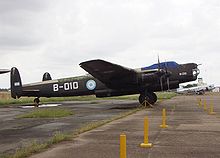
Picture - B-004 on display in Argentina
Four aircraft have survived:
Lincoln II B-004 On display as B-010 at the National Museum of Aeronautics, Buenos Aires, Argentina. Lincoln II B-016 A gate guardian at the Villa Reynolds airbase, San Luis Province, Argentina Lincoln II RF342 In storage for future restoration at the Australian National Aviation Museum, Melbourne, Australia. Lincoln II RF398 On display at the Royal Air Force Museum Cosford, United Kingdom.
Specifications (Lincoln I)
Data from Aircraft of the Royal Air Force 1918-57
General characteristics
Crew: 7 (pilot, flight engineer/co-pilot, navigator, wireless operator, front gunner/bomb aimer, dorsal and rear gunners)
Length: 78 ft 3½ in (23.86 m)
Wingspan: 120 ft (36.58 m)
Height: 17 ft 3½ in (5.27 m)
Wing area: 1,421 ft² (132.01 m²)
Empty weight: 43,400 lb (19,686 kg)
Loaded weight: 75,000 lb (34,100 kg)
Max takeoff weight: 82,000 lb (37,273 kg)
Powerplant: 4x— Rolls-Royce Merlin 85 V piston engine, 1,750 hp (1,305 kW) each
Performance
Maximum speed: 319 mph (475 km/h) at 18,800 (5,640 m)
Cruise speed: 215 mph (346 km/h) at 20,000 ft (6,100 m)
Range: 2,930 mi (4,720 km) with maximum bomb-load 1,470 miles (2,370 km)
Service ceiling: 30,500 ft (9,295 m)
Rate of climb: 800 ft/min (245 m/min)
Armament
Guns: 2 x— .50 in (12.7 mm) M2 Browning machine guns in nose and tail turrets, and dorsal turret with either twin .50 in machine guns or twin 20 mm Hispano cannon.
Bombs: Up to 14,000 lb (6,400 kg) of bombs (normal maximum). Exceptionally one 22,000 lb (10,000 kg) DP bomb.
Related development
Avro Lancaster
Avro Tudor
Avro Shackleton
Comparable aircraft
Boeing B-29 Superfortress
Boeing B-50 Superfortress
Consolidated B-32 Dominator
Messerschmitt Me 264
Tupolev Tu-4
Vickers Windsor
Citations
Bibliography
Buttler, Tony. Avro Lincoln (Warpaint series no. 34). Denbigh East, Bletchley, UK: Hall Park Books, 2000.
Franks, Richard A. The Avro Lancaster, Manchester and Lincoln. Bedford, United Kingdom: SAM Publications, 2000. ISBN 0-9533465-3-6.
Garbett, Mike and Brian Goulding. Lincoln at War. Shepperton, Surrey, UK: Ian Allan Ltd, 1979. ISBN 0-7110-0847-7.
Jackson, A.J. Avro Aircraft since 1908, 2nd edition. London: Putnam Aeronautical Books, 1990. ISBN 0-85177-834-8.
Lake, Alan. Flying Units Of The RAF. London: Airlife Publishing Ltd, 1999. ISBN 1-84037-086-6.
Marino, Atilo, Vladimiro Celleto and Javier Mosquera. "Argentina's 'Heavies': Avro Lancaster, Lincoln and Lancastrian in Military Service: Part One." Air Enthusiast, No. 95, September/October 2001, pp. 64-70. Stamford, UK. Key Publishing. ISSN 0143-5450.
Marino, Atilo, Vladimiro Celleto and Javier Mosquera. "Argentina's 'Heavies': Avro Lancaster, Lincoln and Lancastrian in Military Service: Part Two." Air Enthusiast, No. 97, January/February 2002, pp. 36-43. Stamford, UK. Key Publishing. ISSN 0143-5450.
Mason, Francis K. The British Bomber since 1914. London: Putnam, 1994. ISBN 0-85177-861-5.
Scholefield, R.A. Manchester Airport. Stroud, Gloucestershire, UK: Sutton Publishing, 1998. ISBN 0-7509-1954-X.
Thetford, Owen. Aircraft of the Royal Air Force 1918-57. London: Putnam, 1957.
Avro Lincoln Pictures and Avro Lincoln for Sale.
Living Warbirds: The best warbirds DVD series.
Source: WikiPedia